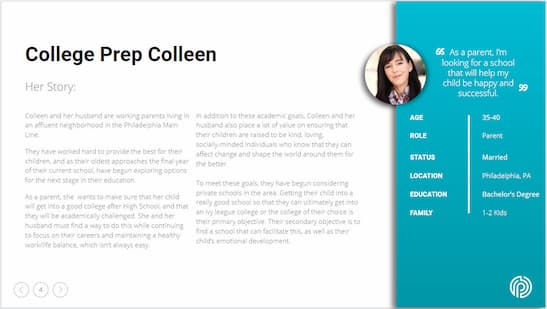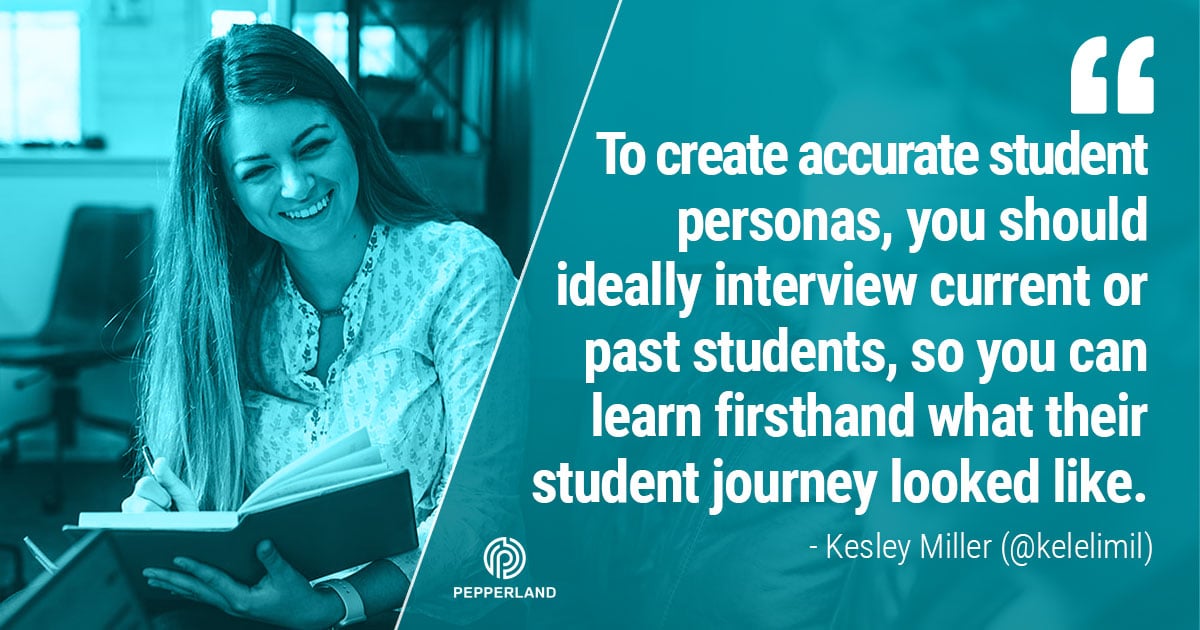
Written By:
Sean Henri
Student personas are semi-fictional representations of your ideal student applicant, covering everything from basic demographics to the types of questions these students may ask. Creating student personas will allow you to carefully target your marketing efforts to attract your ideal students. To create a student persona:
-
Focus on the WHO, WHAT, WHY, and HOW
-
Talk to your admissions team about the personas they encounter
-
Look at analytics data
-
Conduct interviews and surveys
Under increasing competition and stagnant or even declining enrollment numbers, your undergraduate enrollment marketing team is resolving to use inbound marketing to attract prospective students to the website, increase applications and boost enrollment.
But how will you know what content to create, or that your messaging is resonating with the ideal students and parents? How will you know the visitors you are attracting are the right ones, and make sure the applications you’re generating are of quality?
To answer these questions, you need a crystal clear view of what the ideal student applicant looks like. This is where student personas come in.
Free Toolkit – Create Student Personas For Your School
What are student personas?
A student persona is the higher-ed equivalent of a “buyer persona” in the corporate world. It is a semi-fictional representation of your ideal student applicant based on market research and a mix of qualitative and quantitative data of your existing students.

A persona profile should cover your ideal student’s basic demographics (age, income, location), motivations and priorities, common behavior and technology preferences, and most importantly—the questions they are asking along their journey towards application and enrollment.
Student personas are the foundation of any good inbound marketing strategy and will help your team:
- Act as a reminder that the content and experiences we create are for real people, not just anonymous visitors to the website.
- Write in a way that better connects with the reader, by aligning content to the reader’s background, experiences, needs, and interests.
- Generate new ideas for content. (What questions are they asking that we aren’t yet answering on our website? How can we reach them earlier in their journey?)
Personas can be helpful for other groups your school serves as well, such as alumni, donors, or parents of prospective students. Each group views your higher ed institution through a different lens, and personas will help you to tailor their experiences to their unique needs and interests.
The real beauty of personas is that they aren’t just built on assumptions, they are based in actual research. Developing these detailed personas forces you to research, test and validate assumptions that have long stood unchallenged. This can significantly transform the effectiveness of your marketing efforts.
How to create student personas
Hopefully by now we’ve convinced you that this is a “must-have” for your school, and not just a fancy buzzword the marketing industry likes to toss around. The most effective marketing teams tailor all off their efforts by persona—campaigns, content, and the entire web experience.

Wondering how to build your own? Let’s dive in.
An easy way to think about it is to make sure personas answer 4 basic questions: Who, What, Why and How.
- WHO—Who are they? What is a common background among your ideal prospective students? Do they come from a certain geographic area? Certain high schools? What are their ages, typical household incomes, and lifestyles? Do they have certain cultural perspectives or beliefs that align well with your school’s mission and values?
- WHAT—What are their primary goals, challenges? What is their motivation for attending college? Is it to secure a good job or are they more interested in the on-campus experience? What’s their criteria for selecting a school? What financial barriers exist? Does distance from family matter? What can we do to help them achieve their goals and overcome any challenges?
- WHY—This is where you can incorporate actual student quotes that speak to the real drivers behind their goals and challenges. Why does attending a top-tiered institution really matter to them? Or does it? What objections or concerns do they have that might keep them from applying, enrolling, or even deciding to seek a degree in the first place?
- HOW—What is our solution to their goals and challenges? What is your school’s value proposition to this type of student?
Sourcing this information will take a bit of time if done correctly. A great place to start is to talk to your admissions team and identify who they believe their most common personas to be. What makes for a good lead? What questions or objections do they encounter the most?
You’ll also want to look at your analytics data. See where visitors are coming from and identify the most common paths that they take when navigating your site. What content do they view before applying? Where do visitors tend to drop off? Trends should start to emerge that can inform your efforts.
Most importantly, you’ll want to run interviews with a mix of current and prospective students and their parents to discover what they like or don’t like about your institution or programs. Using the information you’ve collected internally, create an interview guide that walks them through their decision making process. If they are a new student, you could ask them to think back on what made them consider your school in the first place. Some sample questions might be:
- How did you research your options?
- What convinced you that this school was the best fit?
- What did it feel like when you were accepted?
- Did you have any doubts along the way? If so, what were they?
Interviews will provide you with the greatest insights, but if you’re pressed for time, a survey with a similar set of questions could be useful. The data you capture might not be as rich, but you’ll still uncover some meaningful insights and may be surprised by the response.
Once you’ve gathered the necessary data, you’ll want to create a formal document that can be shared among your team and refined over time. To help get you started we’ve created an easy-to-use Powerpoint template along with a few additional resources in our Personas for Higher Education Toolkit. You can also find a few good examples online, including this one from Yale University, and this one from the University of Louisiana.
Now that you understand the meaning of the student persona, its general purpose, and how to create one, you can move on to refining it in the following sections. The following articles will help you to get more specific about your student personas and even introduce you to the concepts of multiple, negative, and alumni personas. They all contribute to a more dignified and specific marketing approach that will bring your higher ed institution closer to potential students and put you in a position to nurture their experience from attraction to graduation and beyond.








